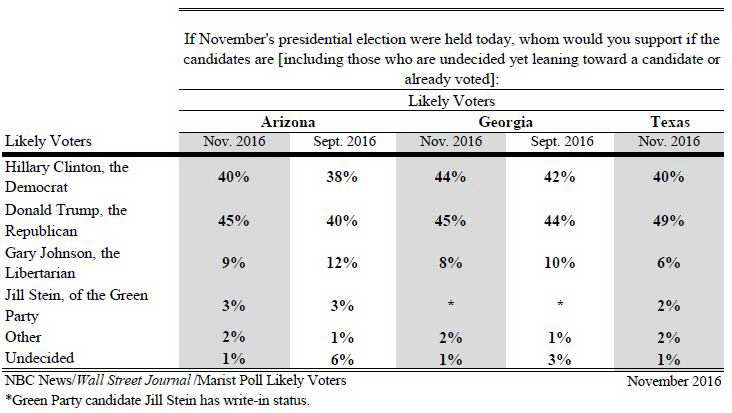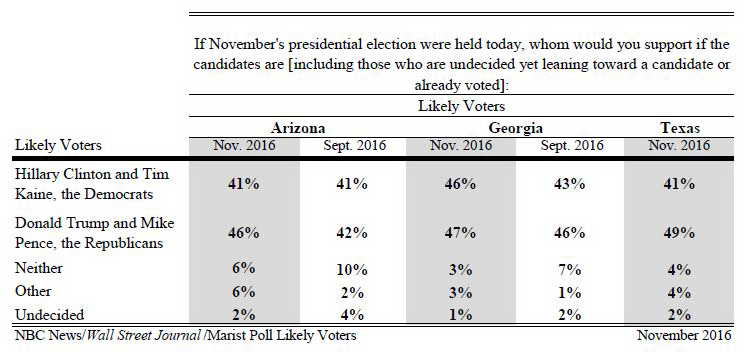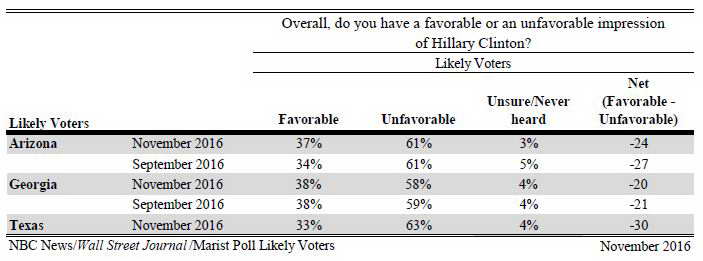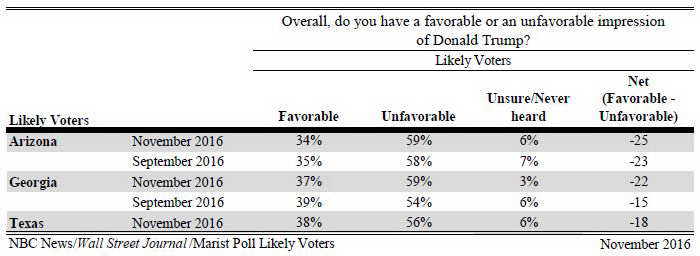November 4, 2016
11/4: Arizona, Georgia, Texas Last Looks
NBC News/WSJ/Marist Poll
In Arizona, Republican Donald Trump, 45%, leads Democrat Hillary Clinton, 40%, by 5 points among likely voters statewide including those who are undecided yet leaning toward a candidate or who have already voted. Nine percent support Libertarian candidate Gary Johnson, and 3% are for Green Party candidate Jill Stein. Two percent support another candidate, and 1% are undecided.
When the NBC News/Wall Street Journal/Marist Poll last reported this question in September, Trump had the support of 40% of likely voters to 38% for Clinton. 12% backed Johnson, and 3% supported Stein. One percent were for another candidate, and 6%, at that time, were undecided.
In Georgia, Trump, 45%, and Clinton, 44%, are competitive among likely voters statewide including those who are undecided yet leaning toward a candidate or who have already voted. Johnson has the support of 8% while 2% support another candidate. One percent of Georgia likely voters are undecided. Of note, Stein has write-in status in Georgia.
Previously, Trump, 44%, and Clinton, 42%, were also competitive among likely voters in Georgia. 10% supported Johnson, and 1% backed another candidate. Three percent, in September, were undecided.
In Texas, Trump receives 49% to Clinton’s 40% among likely voters statewide including those who are undecided yet leaning toward a candidate or who have already voted. Johnson garners 6% while Stein has 2%. Two percent are for another candidate, and 1% are undecided.
“These three states test the significance of the changing demography for the 2016 election,” says Dr. Lee M. Miringoff, Director of The Marist College Institute for Public Opinion. “What we’re seeing is that, in each case, the races are much closer than the Obama/Romney contest four years ago. But, with the exception of Georgia, the electoral votes in Texas and, probably, Arizona are likely to land in Trump’s column.”
In Arizona, 86% of Democrats are for Clinton, and 86% of Republicans are for Trump. While Clinton’s support among Democrats is unchanged from an identical 86% in September, Trump’s support has inched up from 80% among Republicans. Trump’s support among independents is also on the rise. 40% of Arizona independents who are likely to vote, up from 30% previously, are for Trump. Clinton receives 33% of independents, unchanged from September. 18% of these voters support Johnson which is little changed from his previous 19%. Of note, only 1% of independent likely voters are undecided, down from 11%.
Looking at race, 51% of white likely voters in Arizona, up from 45%, support Trump compared with 34% for Clinton. Clinton’s support is little changed from the 33% she received in the previous NBC News/Wall Street Journal/Marist Poll. However, Clinton’s support among Latino likely voters is up, 59% from 49% in mid-September. Trump’s support, 24%, among Latino likely voters is little changed from 28% in that previous poll.
Trump’s lead among white likely voters without a college degree has grown in Arizona. He currently leads Clinton among these voters, 60% to 27%, a 33-point advantage. Previously, Trump was ahead of Clinton by 23 points, 51% to 28%. Clinton, 43%, and Trump, 41%, are competitive among white likely voters with a college degree. In the September survey, Clinton and Trump were tied at 39%.
Trump, 47%, also maintains a double-digit lead over Clinton, 37%, among men likely to vote in Arizona. In the previous survey, Trump was also ahead of Clinton by 10 points. Trump, 44%, and Clinton, 43%, are competitive among women. Clinton, 42%, previously had a 5-point edge over Trump, 37%, among these voters.
In Georgia, most Democrats, 91%, support Clinton while most Republicans, 93%, support Trump. Among independents who are likely to vote, Trump leads Clinton, 40% to 34%. While Clinton’s support is unchanged from 34% previously, Trump’s backing has increased from 33%. Johnson currently receives 20% of independents, down slightly from 25% in September.
Clinton, 89%, continues to outpace Trump, 5%, among African Americans likely to vote in Georgia. Among white likely voters, Trump, 63%, still outdistances Clinton, 25%, by more than two to one.
A gender gap is also present in Georgia. Trump, 49%, has a double-digit lead over Clinton, 37%, among men. Among likely voters who are women, 50% support Clinton while 42% are for Trump.
Looking at race and education in Georgia, Trump, 73%, is out in front of Clinton, 17%, among white likely voters without a college education. Among those with a college degree, Trump, 53%, also has the advantage over Clinton, 34%.
Unless otherwise specified, there has been little change since the previous poll among the demographic subgroups highlighted above in the Georgia survey results.
In Texas, Clinton, 93%, and Trump, 91%, carry their respective party’s base. Among independents likely to vote, Clinton receives 42% to 34% for Trump. 15% of independents back Johnson while Stein has 4%.
Looking at the racial breakdown in Texas, Trump, 68%, leads Clinton, 20%, by more than three to one among white likely voters. Among African Americans who are likely to cast a ballot, Clinton has 88% to just 6% for Trump. Among Latino likely voters, about two-thirds, 66%, are for Clinton while 24% support Trump.
When education and race are considered in Texas, Trump leads Clinton among white likely voters regardless of whether or not they have a college education. Among those without a college degree, Trump, 72%, outpaces Clinton, 17%. Trump, 64%, also outdistances Clinton, 23%, among white likely voters with a college degree. Trump, 53%, also has the advantage over Clinton, 32%, among men who are likely to vote. Clinton, 46%, and Trump, 45%, are competitive among women.
Among registered voters in Arizona, Trump has 44% to 39% for Clinton. 10% support Johnson, and 4% are for Stein. Two percent back another candidate, and 1% are undecided.
In Georgia, 44% of registered voters statewide support Trump, and 43% are for Clinton. Johnson receives the backing of 10%. Two percent are for another candidate, and 1% are undecided.
Among registered voters in Texas, 45% support Trump while 41% are for Clinton. Johnson garners 7%, and 3% are for Stein. Three percent of registered voters are for another candidate, and 2% are undecided.
Turning to the two-way contest between just Clinton and Trump in Arizona, Trump leads Clinton, 46% to 41%, among likely voters statewide including those who are undecided yet leaning toward a candidate or who have already voted. Six percent do not support either candidate, and 6% back someone else. Two percent are undecided. Among likely voters with a candidate preference, 62% strongly support their choice of candidate. 62% of Trump’s backers, compared with 63% of Clinton’s supporters, say they are firmly committed to their presidential selection.
In the head-to-head contest in Georgia, Trump, 47%, and Clinton, 46%, are competitive among likely voters statewide including those who are undecided yet leaning toward a candidate or who have already voted. Three percent do not support either Trump or Clinton, and 3% back another candidate. One percent are undecided. Among likely voters with a candidate preference in Georgia, 67% say they strongly support their selection for president. 70% of Trump’s supporters and 65% of Clinton’s backers say they will not change their minds before Election Day.
In the two-way competition between Clinton and Trump in Texas, Trump has 49% to 41% for Clinton among likely voters statewide including those who are undecided yet leaning toward a candidate or who have already voted. Four percent do not support either candidate, and 4% back someone else. Two percent are undecided. 63% of likely voters with a candidate preference in Texas say they strongly support their candidate selection for U.S. President. 67% of Trump’s supporters, compared with 57% of Clinton’s backers, say they will not waver in their commitment to their choice of candidate.
In all three states, Clinton and Trump have upside down favorable ratings with high net negative scores. In Arizona, Clinton has a favorable rating of 37% and an unfavorable score of 61% among likely voters statewide, a net negative of 24 points. This is comparable to the 27-point net negative score Clinton garnered in September. Trump’s favorable rating is 34% among likely voters in Arizona, and his unfavorable score is 59%, a net negative of 25 points. This is relatively unchanged from 23 points previously.
In Georgia, Clinton has a net negative score of 20 points, comparable to 21 points in September. 38% of likely voters in Georgia currently have a favorable opinion of Clinton while 58% have an unfavorable one. Trump’s net negative in the state is 22 points, an increase from 15 points previously. 37% of Georgia likely voters currently have a positive impression of Trump while 59% do not.
In Texas, Clinton’s net negative score among likely voters is 30 points. 33% of likely voters in Texas have a favorable opinion of Clinton while 63% have an unfavorable one. Trump fares a little better in the Lone Star State. Trump’s net negative is 18 points. He receives a favorable score of 38% among likely voters in Texas while his unfavorable rating is 56%.
“Not only are their ratings upside down, but neither Clinton nor Trump reaches 40% in their favorable ratings in each of these three states,” says Dr. Lee M. Miringoff, Director of The Marist College Institute for Public Opinion.”
In the race for U.S. Senate in Arizona, Republican incumbent John McCain, 55%, leads his Democratic challenger Ann Kirkpatrick, 39%, by 16 points among likely voters statewide including those who are undecided yet leaning toward a candidate or who have already voted. Five percent support another candidate, and 2% are undecided. McCain, 57%, had a similar 19-point lead over Kirkpatrick, 38%, among likely voters in the previous NBC News/Wall Street Journal/Marist Poll of Arizona. 47% of likely voters with a candidate preference for U.S. Senate in Arizona say they strongly support their choice of candidate. 49% of McCain’s supporters, compared with 45% of Kirkpatrick’s backers, report they will not change their minds prior to Election Day.
In the Georgia Senate race, 48% of likely voters statewide including those who are undecided yet leaning toward a candidate or who have already voted support Republican incumbent Johnny Isakson. Democrat Jim Barksdale has the backing of 37% of likely voters, and Libertarian candidate Allen Buckley garners 7%. Three percent support another candidate, and 5% are undecided. 53% of likely voters with a candidate preference for U.S. Senate in Georgia say they are firmly committed to their choice of candidate. 58% of Isakson’s backers and 52% of Barksdale’s supporters report they are strongly committed to their choice of candidate.
Looking at the favorable score of prominent, sitting U.S. Senator Ted Cruz of Texas, Cruz’s favorable rating is upside down. 41% of likely voters say they have a positive opinion of Cruz while 46% have a negative one. 12% have either never heard of Cruz or are unsure how to rate him.
How does President Barack Obama’s job performance fare in Arizona, Georgia, and Texas? Arizona residents divide. 47% of adults statewide approve of how the president is doing his job while 45% of residents disapprove. Eight percent are unsure. In September, 48% thought well of the president’s job performance while 44% did not. Seven percent, at that time, were unsure. Of note, the president’s approval rating is upside down among likely voters in Arizona. 45% approve of how he is doing his job while 50% disapprove.
“Obama’s approval rating is stronger than Clinton’s support in each of these three states,” says Dr. Lee M. Miringoff, Director of The Marist College Institute for Public Opinion.
In Georgia, 50% of residents, including 48% of likely voters, approve of how President Obama is performing in office. 43% of adults statewide disapprove, and 7% are unsure. Previously, Georgia residents divided. 47% approved of the president’s job performance, and 45% disapproved. Eight percent, at the time, were unsure.
In Texas, 49% of residents approve of how President Obama is doing his job. 44% disapprove, and 7% are unsure. Of note, the president’s approval rating in Texas is upside down, 43% to 51%, among the likely statewide electorate.
Marist Poll Methodology for Arizona
Nature of the Sample for Arizona
Marist Poll Methodology for Georgia
Nature of the Sample for Georgia





